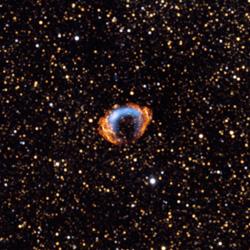About 140 years ago, evidence of a star’s explosion reached Earth.
Twenty-three years ago, researchers noticed and recorded data for a small object that, at the time, was astronomically uninteresting.
Last year, Stephen Reynolds, a professor of physics, and his team took another look at the remnants of the exploded star and noticed something unusual: it was still growing at a constant rate.
When Reynolds announced in May that the supernova, G1.9+0.3, was only about 100 years old, the blogging world went up in arms.
According to Reynolds, they claimed the G1.9+0.3 was actually 25,000 years — which is the the speed of light — plus 100 years.
While that’s true, Reynolds said, the researchers do not factor the speed of light into the equation. But in a universe where most remnants are millions and billions of years old, and in a galaxy where the youngest known supernova is 330 years old, Reynolds said it was still an impressive discovery.
“What we got is not really a baby, but perhaps a toddler,” he said.
The supernova is the youngest known out of only about 10 recorded supernovas in the Milky Way, Reynolds said. This figure is substantially less than the number of supernovas that occur in other galaxies.
“Somebody isn’t paying our supernova bill,” he said. “Either they’re not happening or they’re happening invisibly. Is our galaxy really more unusual than other galaxies?”
To answer this question, Reynolds and his team decided to find and study smaller radio remnants and examine the X-rays they emit. Most of the ones they found were 1,000 to 2,000 years old. This one was the smallest-appearing radio supernova.
“Somebody ought to chase it down, we thought,” he said.
They examined it more closely using the Chandra x-ray telescope, comparing it to radio data that had been recorded in 1985.
It had grown by 16 percent, the ring expanding out much farther than it had upon first observation.
“It had been expanding at a constant rate,” he said.
When a star explodes, it expels both bursts of radiation and nearly all of the star’s content. It expands quickly and, in its journey outward, collects a shell of dust and gaseous material. As the supernova ages, it starts expanding at a slower pace.
Since, when Reynolds looked at G1.9+0.3, it had expanded at such a constant rate since the last time researchers observed it, they knew something was different about this supernova.
If it was as old as the other supernovas they’d been studying, it would have hardly grown at all in 23 years.
“Supernovas do increase in size,” Reynolds said. “It’s little, tiny increases in size, but they do grow. That growth, though, isn’t nearly as spectacular as this.”
Using that information, Reynolds and his team determined G1.9+0.3’s age.
“It was definitely, definitely exciting to find that,” he said.
Supernovas usually emit radio waves that, once they gets here, can light up the sky.
So why hadn’t anyone seen it?
Reynolds claims the delay of its discovery lies not in the fact that no one was looking, but that the “optical obstacles and gunk in our galaxy” were preventing anyone from seeing the light typical to a star’s explosion.
Once the team determined the supernova’s age, they submitted a proposal on Friday to observe it again, this time in more detail. It was accepted on Monday, and the team went to the Chandra observatory on Tuesday.
And what they found didn’t disappoint.
“This is absolutely in your face, not doubt about it.”
Now, the researchers are watching G1.9+0.3 more closely and seeing how it grows with time, Reynolds said.
“This is more of an opening door than a final result,” he said. “From a science point of view, it granted us the opportunity to look at it for a much longer time. … There just aren’t a whole lot of objects waiting to be discovered.”
Reynolds said he and other researchers will use this information to learn more about how cosmic rays are produced and why the Milky Way has such fewer recorded supernovas.
“Now the fun starts.”








